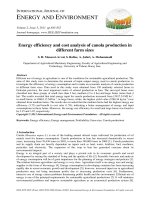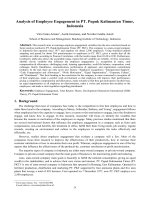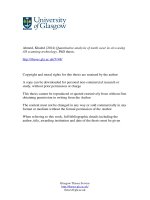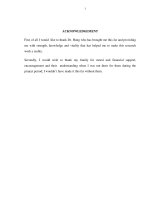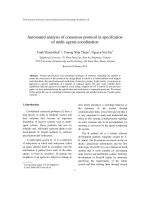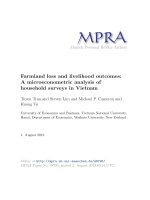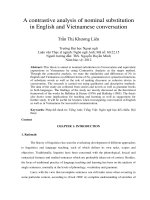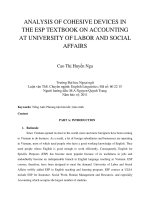Analysis of product upgrading in weaving value chain addis ababa shiromeda
Bạn đang xem bản rút gọn của tài liệu. Xem và tải ngay bản đầy đủ của tài liệu tại đây (925.21 KB, 85 trang )
SCHOOL OF GRADUATE STUDIES
DEPARTMENT OF GEOGRAPHY AND ENVIRONMENTAL
STUDIES (POPULATION, RESOURCES AND
DEVELOPMENT STREAM)
ANALYSIS OF PRODUCT UPGRADING IN WEAVING VALUE
CHAIN: ADDIS ABABA SHIROMEDA
M.A. Thesis
By:
Zerihun Alebachew
July, 2017
Addis Ababa University
i|Page
ANALYSIS OF PRODUCT UPGRADING IN WEAVING
VALUE CHAIN: ADDIS ABABA (SHIRO MEDA)
A Thesis Submitted to the School of Graduate Studies of Addis Ababa
University in Partial Fulfillment of the Requirements for the Degree of
Masters of Art in Population, Resources and Development
By
Zerihun Alebachew
Advisor
Tebarek Lika(PhD)
July, 2017
ii | P a g e
Statement of the Researcher
I solemnly declare that this thesis has not been presented to any other institution anywhere for
the award of any academic degree, diploma, or certificate and it is my authentic work and that all
sources of materials used for this thesis have been duly acknowledged.
This thesis is to be submitted in partial fulfillment of the requirements for M.A degree at Addis
Ababa University and it will be made available at the university libraries to borrowers under
rules of the Library.
Brief quotations from this thesis are allowing without special permission, except
acknowledgements of the source. Requests for permission for extended quotation or coping of
the thesis in whole or in part may be granted by the head of the department or the School of
Graduate Studies Dean. In all other instances, however, permission must be obtained from the
author.
iii | P a g e
Addis Ababa University
School of Graduate Studies
This is to certify that the thesis prepared by Zerihun Alebachew, titled: Analysis of Product
Upgrading in Weaving Value Chain in Addis Ababa: Shiro Meda for the Degree of Master of
Arts (in Population, Resources and Development) complies with the regulation of the University
and meets the accepted standards with respect to originality and quality.
Approved by the examining committee:
Advisor
Signature
Date
Dr. Tebarek Lika
Examiner
Signature
Prof. Tegegn Gebre-Egizaber
Examiner
Dr. Kassa Teshager
___________________
Signature
___________________
Date
____________
Date
_______________
Chair of Department of Graduate Program
__________________________________________________________________________
iv | P a g e
Acknowledgement
Special thanks to the omnipotent God for his guidance to my work come to success.
My thanks go to my advisor Dr. Tebarek Lika for his guidance that made this thesis possible. I
also appreciate his tolerance during the course of this work and enthusiasm to see the best of this
study. I really cannot stop be thankful for his outstanding guidance and comments throughout the
course of the study.
And thanks to also my informants for their fortitude in providing me with all the information I
wanted for this study.
i|Page
Acronyms and Abbreviations
AACCSA
Addis Ababa Chamber of Commerce & Sectoral Associations
C/HMI
Cottage/Handicraft Manufacturing Industry
CSA
Central Statistics Authority
ESD
Education for Sustainable Development
ETB
Ethiopian Birr
EDRI
Ethiopian Development Research Institute
FOP
Factor of Production
GNI
Gross National Income
HIE
Higher Income Economies
ILO
International Labor Organization
LIE
Lower Income Economies
LMIE
Lower Middle Income Economies
MSEs
Micro and Small Enterprises
PLC
Private Limited Company
PPP
Purchasing Power Parity
SSEA
Small Scale Enterprise Administration
TIDA
Trade and Industry Department Administration
TWI
Traditional Weaving Industry
UMIE
Upper Middle Income Economies
UNIDO
United Nation Industrial Development Organization
USAID
United States Agency for International Development
VCA
Value Chain Analysis
WB
World Bank
ii | P a g e
Table of Contents
List of Contents
Page
Acknowledgement ........................................................................................................................... i
Acronyms and Abbreviations ......................................................................................................... ii
Table of Contents........................................................................................................................... iii
List of Contents.............................................................................................................................. iii
List of Tables .................................................................................................................................. v
List of Figures ................................................................................................................................. v
Abstract ......................................................................................................................................... vii
CHAPTER ONE ........................................................................................................................... 1
INTRODUCTION......................................................................................................................... 1
1.1. Background of the study .......................................................................................................... 1
1.2. Statement of the Problem......................................................................................................... 3
1.3. Objectives................................................................................................................................. 5
1.3.1. General Objective............................................................................................................. 5
1.3.2 Specific Objectives............................................................................................................ 5
1.4. Research Questions .................................................................................................................. 5
1.5. Significance of the Study ......................................................................................................... 5
1.6. Scope and Limitation of the Study........................................................................................... 6
1.7. Organization of the Paper ........................................................................................................ 6
CHAPTER TWO .......................................................................................................................... 7
LITERATURE REVIEW ............................................................................................................ 7
2.1. Definition of Value Chain........................................................................................................ 7
2.2. Forms of Value Chain.............................................................................................................. 8
2.2.1 The Simple Value Chain.................................................................................................. 8
2.2.2 The Extended Value Chain .............................................................................................. 9
2.3. Importance of Value Chain Analysis (VCA)........................................................................... 9
2.4. Value Chain Upgrading ......................................................................................................... 10
2.5. Product Upgrading ................................................................................................................. 11
2.6. Weaving Value Chain Map.................................................................................................... 14
2.7. Weaving Value Chain in Ethiopia ......................................................................................... 16
iii | P a g e
2.8. Review of Empirical Studies ................................................................................................. 20
2.9. Conceptual Framework .......................................................................................................... 23
CHAPTER THREE .................................................................................................................... 24
RESEARCH METHODOLOGY .............................................................................................. 24
3.1. Description of the Study Area................................................................................................ 24
3.2. Research Design..................................................................................................................... 26
3.3. Sources of Data and Method of Data Collection ................................................................... 26
3.4. Sample Size Determination and Sampling Technique........................................................... 26
3.5. Method of Data Analysis ....................................................................................................... 28
CHAPTER FOUR....................................................................................................................... 29
RESULTS AND DISCUSSION ................................................................................................. 29
4.1. Demographic Characteristics of Sample Respondents .......................................................... 29
4.1.1. Demographic Characteristics of Producer and Processer Respondents ......................... 29
4.1.2. Demographic Characteristics of Trader Respondents .................................................... 32
4.1.3. Demographic Characteristics of Consumers .................................................................. 36
4.2. Weaving Production............................................................................................................... 38
4.3. Upgrading Weaving Product by Processing .......................................................................... 43
4.4. Traders Commercial Activities .............................................................................................. 47
4.5. Weaving Product in the Eyes of Consumers.......................................................................... 50
4.6. Value Chain Mapping of Weaving Product ........................................................................... 53
CHAPTER FIVE ........................................................................................................................ 55
CONCLUSION AND RECOMMENDATIONS...................................................................... 55
5.1. Conclusion ............................................................................................................................. 55
5.2. Recommendations.................................................................................................................. 57
References..................................................................................................................................... 59
APPENDIX................................................................................................................................... 63
iv | P a g e
List of Tables
Table 3.1: Total Population and Sample Distribution
28
Table 4.1: Producer and Processor Sample Respondents Distribution by Sex
29
Table 4.2: Trader Respondents Distribution by Sex
33
Table 4.3: Distribution of Consumer Respondents by Sex
37
Table 4.4: Producer raw material sources
39
Table 4.5: Price determination of weaving product
39
Table 4.6: Year of experiences of sample Producer and Processor
40
Table 4.7: Learning weaving production
41
Table 4.8: Average income of producers from per unit product eg. kemis
41
Table 4.9: Purchasing power parity (PPP) of sample Producer and Processor
42
Table 4.10: Price determination of weaving final product
47
List of Figures
Figure 2.1: Four links in a simple value chain
8
Figure 2.2: The value chain approach; Map of weaving value chain
14
Figure 2.3:Traditional weaving products value chain map
15
Figure 2.4:Micro level actors of traditional weaving products value chain map
16
Figure 2.5: Conceptual Framework
23
Figure 3.1: Geographical map of the study area
25
Figure 4.1: Producer and Processor sample respondent distribution by age group
30
Figure 4.2: Producer and Processor respondent distribution by marital status
31
Figure 4.3: Producer and Processor sample respondent distribution by educational level
32
Figure 4.4: Trader respondent distribution by age category
34
v|Page
Figure 4.5: Trader respondent distribution by marital status
35
Figure 4.6: Trader respondent distribution by educational level
36
Figure 4.7: Distribution of Consumer respondent by age group
37
Figure 4.8: Distribution of Consumer respondent by marital status
38
Figure 4.9: Production of weaving product
42
Figure 4.10: Production of weaving product
43
Figure 4.11: Price and contract agreement
44
Figure 4.12: Constraints in the process of weaving product
45
Figure 4.13: Processing of weaving product
46
Figure 4.14: Processing of weaving product
46
Figure 4.15: Trader judgment in the current weaving price
47
Figure 4.16: Customers of Traders
48
Figure 4.17: Trading of weaving product
49
Figure 4.18: Trading of weaving product
50
Figure 4.19: Consumer of weaving product
51
Figure 4.20: Consumer of weaving product
52
Figure 4.21: Income category of consumers
53
Figure 4.22: Product upgrading of value chain map in weaving sector
54
vi | P a g e
Abstract
The study was conducted in Addis Ababa city, specifically in Gulele sub-city woreda 1 with a
focus on Shiro Meda Shemma production and market areas where most of the actors of
traditional weaving products are operating.
The study aimed at analyzing of product upgrading in weaving value chain. The study used both
primary data sources and has used descriptive data analysis method with tabular
representations, diagrams and graphs. Random sampling and purposive sampling techniques
have been applied in order to fix the number of sample respondents.
The weaving products pass many phases such as production, processing, trading and
consumption and all actors are involved in the process of changing the raw materials and
making available for consumption. The traders are the ultimate supplier for consumers, they
have role to channel weaving products at a given price and those of consumers show growing up
demand. The income of the actors in different stage show significant increments, however not for
all.
Credit arrangement system, advanced technology and technological tools, advertising and
promotion as well as production with economies of scale improve the productivity of actors in
short run. While in the long run including the issue in educational curriculum and create
cultural industry linkage makes the sector efficient and effective in production, processing and
trading of weaving products.
KEY WORDS: Weaving (Shemma), Shiro Meda, Value Chain, Product Upgrading
vii | P a g e
CHAPTER ONE
INTRODUCTION
1.1.
Background of the study
Value chain is the series of activities engaged in changing raw materials into a commodity. It
includes business activities of using raw materials, transforming in to intermediate products, and
manufacturing the final product. It is business transactions between organizations, government
and different institutions. A value chain is a straightforward process and extremely complex
processes that require the involvement of different stakeholder like producer, processor,
packaging houses, wholesaler, retailer etc. (Stamer et. al, 2007:7-8).
Value chain is a pillar in competitiveness of world market, requirement of optimum efficiency to
break up international market and even after entering towards global market it requires sustained
income growth (Kaplinsky et. al, 2000:9).
Upgrading can be defined as “innovation that increases value added” (Giuliani et. al, 2005:549).
According to (Dunn et. al, 2005:17), upgrading can take many different forms, which generally
fit within the following five categories:
Process upgrading: an increase in production efficiency, resulting in either greater output
for the same level of inputs or the same level of output for fewer inputs (optimum
condition); process upgrading reduces the costs of production and it can be caused by
improved organization of the production process or by an improved technology.
Product upgrading: a qualitative improvement in the product that makes it more desirable
to consumers; the higher quality product commands a higher unit price.
1|Page
Functional upgrading: the entry of a firm into a new, higher value-added level in the
value chain and it moves the firm closer to the final consumer and positions to receive a
higher unit price for the product.
Inter-chain upgrading: the entry of a firm into a new and more profitable marketing
channel in the value chain; typically, this would involve moving from the domestic to the
export market for the same product.
Inter-sectoral upgrading: the entry of a firm into a new value chain involving a
completely different product or service.
Product upgrading takes place in a number of approaches. It often occurs in the form of changes
in the colors, textures, and designs that are used in weaving. Product upgrading also occurs
through the development of new ways to combine weaving with other materials in order to create
products for which the weaving is only one component. In this case, traditional textile designs
may be used and product upgrading is more closely associated with the assembly stage that
occurs after the weaving has been completed (Dunn et al, 2005:32).
In Ethiopia, spinning and weaving traditional clothes have a long history. For the centuries
Ethiopians have made traditional clothes from cotton fibers (Bosena et.al. 2011:42). The
handloom weaving sector in Ethiopia is pertained from the cotton sector and it is a traditionalbased and home grown activity. Handloom weaving is of crucial importance in the cotton sector
as it coheres both the rural and urban households together and is grown from the home-based
traditional handcraft industry. Handloom weaving was started to achieve household need and
demand for clothing, and then gradually grew to be an additional source of income as an offfarm activity (AACCSA, 2015:1)
2|Page
1.2.
Statement of the Problem
Ethiopia is rich in both diverse cultural backgrounds and natural resources endowment which
play a great role in expansion and development of crafts skills. Next to agriculture, handicraft, is
the most vital and widely spread occupations in Ethiopia. As part of the handicrafts heritage,
Ethiopia has diverse traditional handloom products. The sub sector delivers tremendous
employment opportunities and an important source of livelihood for a large number of people in
urban and rural areas (Femseda et. al, 2004:1)
In Ethiopia, weaving and spinning traditional clothes have been being practiced by smallholders
and households in small scale levels. They have been utilizing traditional tools and light
machinery. For decades it is the means of income and livelihood for many people. However, the
benefit has been remaining insignificant (Bosena et.al. 2011:42).
Woven clothes from cotton are popular in urban areas of the country. However, the amount of
cotton exported and the amount of revenue generated from the export is low. (Mulat et.al.2004).
Income generated from export of cotton and weaving products in Ethiopia is low when compared
to other commodities. The country is receiving insignificant benefits from its cotton final product
export (Bosena et.al. 2011:42).
The implementation of value chain analysis in cotton and weaving production (through different
steps in value chain processes) is not beneficial for concerned stakeholders who are part and
parcel in these activities. The beneficial approaches of the weaving and cotton were measured
and results reflecting unsatisfactory from the point of price advantage in short run as well as
improving their standard of living in the long run (Bosena et.al. 2011:42).
3|Page
Despite the different bottlenecks that encounters, it is well recognized that the Traditional
Weaving Industry (TWI) is a part and a means for income and employment generation and a
breeding ground for entrepreneurship development in Micro and Small Enterprises (MSEs).
Limited market access, low level of knowledge and skill to compete in the available market are
among the critical challenges faced in weaving sector. The low level of capacity, limited
business relations and communication with the different actors that plays a significant role in
traditional weaving value chains are critical factors that hinder the productivity and
competitiveness (AACCSA, 2015:3)
Some writers and institutions have done important jobs to illustrate the weaving sector such as
Hanna Hofverberg (2010) studied Dorze Weaving in Ethiopia target to analyze the learning
process of the Dorze weaving and its implications on Education for Sustainable Development
(ESD), Gezahegn et.al (2009) studied about infrastructure and cluster development in the case of
handloom weavers in Ethiopia and assess rural non-farm development and its generation of
employment opportunity in many developing countries, Addis Ababa Chamber of Commerce
and Sectoral Associations (2015) prepared report on the study basis entitled of ‘‘Value Chain
Analysis for Weaving Products’’ in area of Addis Ababa city, where most of the actors of
traditional weaving products are operating.
It is important, therefore, to study product upgrading of value chain in weaving sector. The study
may help to narrow the information gap on the subject and it may contribute towards
improvement of strategies for reorienting value chain system.
4|Page
1.3.
Objectives
1.3.1. General Objective
The general objective of the study is to assess product upgrading of value chain in traditional
clothes (Shemma) on Shiro Meda, Addis Ababa.
1.3.2 Specific Objectives
The specific objectives are
To explore product quality improvement and its pricing;
To examine the consumer preference regarding weaving product; and
To derive policy implications based up on the research findings.
1.4. Research Questions
The study has answered the following research questions. These are:
How weaving products pass different stage in value chain processes?
How product upgrading of value chain on a weaving influence price of weaving
products?
To what extent the effect of product upgrading in value chain influence consumer
demand?
1.5.
Significance of the Study
The study uses as a source to the researchers who are interested in the research topic to stimulate
further investigations in related areas. As the researcher believe this topic of research has not
been raised by any scholar in distinct approach (by emphasize only in product upgrading), while
product upgrading is an important concern for developing economy (Trienekens, 2011:69) this
research contribute theoretical significance for other researchers.
5|Page
In other side the research gives a clue to concerned government body to use as input for policy
analysis and as a reference for policy formulation for micro and small scale economic activities
in weaving sector in particular and off-farm sectors in general.
Finally, the research indicates some practical solution for weavers and traders in order to
improve their productivity and efficiency by recommending possible remedies to fill their gap
during production, processing and trading activities.
1.6. Scope and Limitation of the Study
The scope of the study is analysis of product upgrading in weaving value chain: Addis Ababa
(Shiro Meda). This study was conducted in Gulele sub-city woreda 1 and important information
were collected from sample households and actors engaged in weaving sector in the study areas.
Hence, the study was more representative rather than covering wider range of area due to time
and finance constraint. The study also does not represent the whole value chain of weaving in the
country as well as in the city. Rather only focus on specified area (Shiro Meda) and specified
issue (product upgrading). The researcher motivated to study product upgrading due to its high
integration with weaving production and processing activities because most of weaving activities
focuses on product quality improvement in accordance with consumer preference.
1.7. Organization of the Paper
Chapter one presents the introduction part of the research. Chapter 2 presents literature review on
value chain analysis from different sources. Subsequently, description of the study area and
methodologies are presented in Chapter 3. In Chapter 4, results and discussion are presented in
detail. Summary, conclusions, and recommendations are set out in the last chapter.
6|Page
CHAPTER TWO
LITERATURE REVIEW
2.1. Definition of Value Chain
The Porter’s value chain is classified into primary and secondary activities. The primary
activities are involved in the creation of a product or service. It is classified in to five key areas:
(1) Inbound logistics, (2) Operations, (3) Outbound logistics, (4) Marketing and (5) Sales and
services. Secondary activities are supportive activities that include procurement, technology
development, human resources management, and infrastructure (Porter, 1985:38).
A value chain is a strategic network between independent enterprises, within a vertical chain of
activities that compete on a specific market and to satisfy market demands (Porter, 1985:39). An
organization’s competitive advantage is based on its products of value chain. The goal of the
organization is to provide maximum value to the ultimate consumers for the least possible total
cost to the organization, thereby maximizing profit (Porter, 1985:39).
A value chain describes the full range of activities that are requiring to bring a product or service
from conception, through the intermediary phases of production (involving a combination of
physical transformation and the input of various producer services), delivery to final consumers
and final disposal after use (Kaplinsky et al, 2000:4).
Value chain can also be defined as a sequence of target oriented combinations of production
factors that create a marketable product or service from its conception to the final consumption.
This includes activities as design, production marketing distribution and support services up to
the final consumer. The activities that comprise a value chain can be contained within a single
7|Page
firm or divided among different firms, as well as a single geographical location or spread over
wider areas (ILO, 2010).
Generally, value chain is the system of linked steps necessary to transform raw materials into a
finished product or service. In value chain system each step along the way adds to a product’s
value. It is much like a supply chain, except it focuses on how value is added rather than how
raw materials get from one point to the other, because obviously value is adding (Elias, 2014:53).
2.2. Forms of Value Chain
2.2.1 The Simple Value Chain
A simple value chain describes the full range of activities which are required to bring a product
or service from conception, through the different phases of production. These phases are (1)
involving a combination of physical transformation and the input of various producer services,
and (2) delivery to final consumers, and final disposal after use (Kaplinsky et al, 2000:4).
Figure 2.1: Four links in a simple value chain
Adopted from (Kaplinsky et.al, 2000:4)
8|Page
2.2.2 The Extended Value Chain
In reality, value chains are much more sophisticate process than simple value chain due to needs
of more links in the chain. Extended value chain is the process of converting different raw
materials size, shape and textures in to new and useful forms of the commodity (Kaplinsky et al,
2000:4-5).
2.3. Importance of Value Chain Analysis (VCA)
In the given circumstance; the globalization and its influence overwhelming in the worldwide
countries become working for being competitive in the world market. This competitiveness
depends on the number of factors which contribute for product quality and customer attraction
(Kaplinsky et al, 2000:9).
Within such aspect of view, the value chain has significant role in creating competitiveness by
upgrading the product through division of labor, efficiency in production process and adopting
sustainable growing income (Kaplinsky et al, 2000:9).
Value chain analysis (VCA) is important for new producers including poor producers and poor
countries to enter in global markets for sustainable income growth. Value chain analysis also
vital as an instrument in perceiving the policy environment which provides for the efficient
allocation of resources within the domestic economy (AACCSA, 2015:15)
The value chain serves as a guideline for identifying key constraints, opportunities, and
suggested points of intervention for industrial development. The VCA show the circulation of
products, factor of production (FOP) and value addition into key market channels, or end
markets for final consumption (Filip, 2006:9)
9|Page
2.4. Value Chain Upgrading
Upgrading options are defined in the area of value addition, including the search for markets, the
value chain- network structure and the governance form of the chain. Gereffi (1999) defined that
upgrading is a process of improving the ability of a firm or an economy to move to more
profitable and/or technologically sophisticated capital and skill-intensive economic niches.
There are four ways in which economic actors can upgrade, these are increasing the efficiency of
internal operations, enhancing inter-firm linkages, introducing new products and changing the
mix of activities conducted within the firm (Kaplinsky et al, 2000:37).
Trienekens, ( 2011) discussed the value chain upgrading frameworks. These are the followings:
Upgrading of value added production: through innovative products and product
differentiation, innovative processes and innovative marketing activities
Value chain-network upgrading: reaching for the right market and being part of the right
market channel
Upgrading of governance form: choosing the right organizational form with horizontal
and vertical value chain partners.
There are different types of upgrading were involving since from raw material to final product
and also disposal as well as recycle of commodities. However, basically the upgrading activities
operate under process, product, functional and chain sphere. So as to upgrading change the
linkage and distribution of activities in the value chain (Kaplinsky et al, 2000:38)
Upgrading refers to the acquisition of technological capabilities and market linkages that enable
firms to improve their competitiveness and move into higher-value activities (Kaplinsky et al,
2000:38). According to (Fromm, 2007:10), upgrading in firms can take place in the forms of:
10 | P a g e
Process upgrading - increasing the efficiency of internal processes such that these are
significantly better than those of rivals, both within individual links in the chain, and
between the links in the chain.
Product upgrading - introducing new products or improving old products faster than
rivals. This involves changing new product development processes both within individual
links in the value chain and in the relationship between different chain links.
Functional upgrading - increasing value added by changing the mix of activities
conducted within the firm or moving the locus of activities to different links in the value
chain.
2.5. Product Upgrading
Product upgrading is a qualitative improvement in a product that makes it more desirable to the
consumer and earns a higher unit price. For example; new colors and designs in textiles and
handicrafts. It is motivated by changes in end markets; usually rises from changes in consumer
preferences. Producers must upgrade their products to meet consumer preferences (Dunn et.al,
2006:7).
It introduces new products or improving old products faster than rivals. This involves changing
new product development processes both within individual links in the value chain and in the
relationship between different chain links (Kaplinsky et. al, 2002:5)
Product upgrading involves improving product quality (e.g. certification, safety standards,
traceability) or moving to more sophisticated products (e.g. processing, packaging) and is often
linked to process upgrading (Kilelu et. al, 2017:4)
11 | P a g e
Product upgrading also increasing value for consumers by changes in end markets, usually rising
from changes in customer preferences, or the desire for higher value added, higher quality, and
subsequently produce more profitable products and rapidly shift the markets in competitive
manner (micro links, 2006)
A well-functioning value chain transmits information to producers about consumer preferences
and the price signals associated with those preferences. In order to respond to changing demand
in end markets, producers must have information about consumer preferences. One of the best
ways to induced firm owners to invest in product upgrading is to offer them higher prices for
higher quality products (Dunn et.al, 2006:7)
Some of the best information about consumer demand comes to producers through the vertical
linkages that connect producers to end markets. These vertical relationships have the potential to
provide the most accurate information about demand, since firms at the top of the value chain
have the closest commercial contact with consumers (Dunn et.al, 2006:8)
When consumers demand new or different products, the pressure to respond is applied to firms
all the way down the value chain. In addition to offering price premiums for improved products,
buyers also may provide non price incentives, such as technical and design assistance, training
and input advances. These services encourage product upgrading by reducing the costs and risks
of producers (Dunn et.al, 2006:8)
Product upgrading is often motivated by the need to keep pace with current fashions and respond
to buyers’ changing tastes. Information about changing tastes comes from different sources in
the three market channels (Dunn et. al, 2005:33). These are:
Popular and tourist markets, many producers come in direct contact with final consumers
and have a chance to observe what these customers like best.
12 | P a g e
Exclusive shop market channel, it is the shop owner who monitors trends and often
creates the new designs.
Export market channel.
Governance structures have an important influence on the way that product upgrading
information is received and transmitted through the value chain. Information about new products
and designs is usually lay in the vertical relationships between firms. (Dunn et. al, 2005:33).
Another motivation for product upgrading is the need to maintain a market presence by offering
unique products that will attract buyers’ attention. This motivation to innovate is found in all
three market channels. Even within traditional weaving, many artisans constantly experiment
with small innovations (Dunn et. al, 2005:33).
Exporters feel a strong need to create new and innovative product lines. These are used to attract
buyers attending international trade fairs. Unluckily, the development of new product lines can
be costly, and there is a risk that they will not generate enough sales to pay their development
costs (Dunn et. al, 2005:33).
In general product upgrading has become increasingly important as the richer economies have
become more quality conscious and as standards have risen. Some standards are driven by lead
buyers (i.e. supermarkets requiring traceability of food products), others by statutory hygiene
standards in importing countries and others, in response to fair trade and organic demands by
final consumers. The challenge of standards lies in achieving them (to allow market access)
without excluding the poor from the value chain (Mitchell et. al, 2009:3)
Process and product upgrading are closely related because improving product quality often
involves improvements to the production process (Mitchell et. al, 2009:3)
13 | P a g e
2.6. Weaving Value Chain Map
Mapping a value chain facilitates a clear understanding of the sequence of activities and the key
actors and relationships involved in the value chain. This exercise is carried out in qualitative and
quantitative terms through graphs presenting the various actors of the chain, their linkages and
all operations of the chain from pre-production (supply of inputs) to industrial processing and
marketing (UNIDO, 2009:16)
Figure 2.2: The value chain approach; Map of weaving value chain
Sources: Adapted from ACDI/VOCA World Report Fall, 2006)
14 | P a g e

